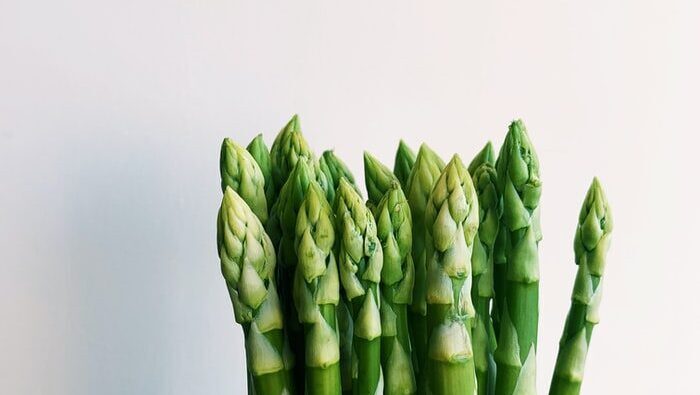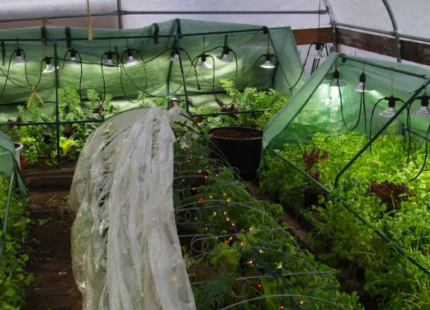
October 7, 2024 • Erica Carmount
PDF version
Interested in learning more about Granskou Greens and handmade salad bowls? Click the link here.
Once thought to be a leisurely activity, urban farming is making a comeback in response to many modern day factors, including the COVID-19 pandemic, increased food costs, and ecological and sustainability concerns regarding industrial agriculture.
Located on the traditional territory lands of the Neutral, Anishinaabeg, and Haudenosaunee Peoples, Granskou Greens is an urban farm operating on just less than one tenth of an acre in Kitchener, Ontario. Run by Sarah Granskou, the all-season urban farm started during the COVID-19 pandemic and evolved in response to a number of environmental conditions on the property, including shade, diseases, invasive tree roots, and small animals.
Inspired by her experience farming and foraging in Norway and Canada, Sarah started growing brassica crops, such as bok choy and cabbage, until the plants developed bacterial soft rot. She then decided to switch to permaculture and planted asian pear, peach and hazelnut trees but they quickly succumbed to small animals.
Switching finally to mainly greens, Sarah soon found that they suited her property best, as the rodents were not interested in them (until the groundhog came!). She quickly expanded her repertoire to include endangered varieties and drought tolerant greens. “If I was to grow common crops all the time, such as lettuce, I would get a build up of diseases. I try to experiment with what works, when it works and how it works”, states Sarah.
For Sarah, the importance of Grønnsakar, or green things, lies not only in its connection to her Norwegian heritage, but also the therapeutic and healing role that stems from eating a diverse range of green things. According to Sarah, “part of that involves consuming in diversity versus consuming a lot of one particular type all the time. That’s kind of the crux of how I operate”. Sarah also does a lot of research on long lost pot herbs that once existed in mainstream European culture but have since disappeared from popular use, including salad burnet, sweet cicely and Good King Henry.


Realizing there was a market for fresh winter produce, Graskou Greens continues from where summer CSAs typically end. “I provide at a time of year when most are purchasing from California”, states Sarah, “My customers get something that you could never buy from a grocery store or the market. They must stretch their culinary approaches and end up healthier for it, more culturally, historically, and ecologically aware while being able to identify dozens of edible plants unfamiliar to most gardeners”.
With the addition of hoop tunnels, cold frames and a 17×27 polytunnel, Sarah is able to grow plants from fall to spring, a time when diseases lay dormant on her property and conditions are more predictable. From both inside and outside, in the winter the farm provides Asian greens, lettuce, microgreens, garlic, carrots, frozen greens, dried produce, herbs and superfoods from warmer climates, as well as cultural plants that represent not only a diversity of diets, but the cultural diversity that we live in. Using low intensity LED grow lights that are safe for outdoors and structures that have a polycarbonate inner layer and polyethylene outer layer covered in wool blankets and other sustainable fibers, it’s just enough heat that even when it’s minus twenty the plants remain in a zero degree climate. Likewise, observing the light on her property, a technique she learned living with the Sámi people in northern Norway, allowed Sarah to identify the sunniest part of the farm season to season.
“It’s a small farm but it’s not just providing for us, it’s providing for the community”.
-Sarah Granskou
Her urban farm now operates on a subscription basis and produces over 300 different varieties of leafy greens and aromatic herbs that cannot be found in the grocery store or market, enough to feed 10-15 families a week plus her own. Her children have also adapted to the farm and for them, leaves are a staple. Collectively, her family now consumes as much as five CSAs worth of greens.
In the summer, Sarah provides fruiting crops, such as tomatoes, beans and cucumbers, mostly in protected growing spaces. She also produces seedlings for ten gardens, and enough donations to give to local food fridges and schools. There is also on-site composting, both inside and outside, including in-ground composting, and the Bokashi method. These characteristics make her farm distinct to an urban garden despite not meeting the requirements to be classified as a farm or to receive the corresponding government funding and tax cuts allocated to farms.
Outside of funding issues, establishing an urban farm comes with other challenges. In addition to shade issues, tree roots, and small animals created opportunities to innovate. Sarah invented tree root barriers and drainage systems in her front beds and a mixture of hardware cloth and rock around structures to prevent small animals from digging.


From her experience working with youth at high schools and local gardening initiatives, such as Nurture and Youth in Food Systems, Sarah notes that another challenge associated with urban farming, especially for youth, is accessing land. While community gardens offer a solution to those who cannot access land, they often have a long waiting list. According to Sarah, however, there are a lot of plants you can grow indoors with grow lights. Sarah works on intensification, which involves raising crops indoors that are then planted outdoors in layers at various heights to maximize space. She uses every corner of her house and property based on what conditions they prefer. “If I can feed 15 families a week on less than one tenth of an acre, including the house, year round, then it’s possible anywhere”, states Sarah. A large part of that includes learning how to do season extension so that you are using the entire year, not just the growing season from May to October.
For Sarah, sustainability, community, and conservation are what drives her urban farm. “I also come at this from a wilderness conservation perspective”, states Sarah, “Our rural lands are threatened, but our wilderness can also be threatened by agriculture. So I think that using these urban spaces as best we can to produce our food, especially things like greens that don’t keep very well, just simply makes sense to me”.



